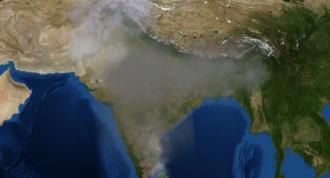
The city of Delhi has been consistently ranked as one of the world's most polluted cities. As the monsoon ends, haze sets in, with Deepawali around the corner, bringing the entire city to a standstill with low visibility. Besides vehicular emissions, smoke from diesel generators and construction dust, a significant contributor to this problem is the practice of crop residue burning by farmers in Punjab and Haryana. Approximately 23 million tonnes of rice residues are up in flames annually in these states. The resulting smoke, high in tiny particulate matter, gushes towards the national capital, exacerbating its air pollution problems.
According to a recent study, published in the journal Nature Sustainability, this environmental crisis of the world's fifth megacity takes its roots in a quick fix employed to solve another ecological crisis. The study involved researchers from Cornell University, USA, and the International Maize and Wheat Improvement Center in India and Mexico. It suggests that groundwater conservation policies, adopted by Punjab and Haryana, have changed the patterns of rice production. These policies, the researchers argue, have led to the concentration of crop residue burning into a narrower period, later in the season.
Farmers in Punjab and Haryana reap the highest yield of rice and wheat crops in the country. Rice is sown during the summer and wheat at the beginning of winter. Now, to make way for wheat plantation at the right time, farmers have to get rid of the residual grass and hay left behind by rice. A faster way to do so is to burn them. Although this practice has been followed since ages, the period of burning was spread out.
Growing rice is lucrative for farmers in this region for many reasons. Besides the high yield, they get subsidies like free electricity for irrigation, assured markets and minimum support price. However, rice is a water-intensive crop and is usually transplanted before the onset of monsoons, resulting in drawing groundwater for irrigation. The two states introduced the 'Punjab Preservation of Subsoil Water Act' and the 'Haryana Preservation of Subsoil Water Act', in 2009 banning transplantation of the crop before the onset of monsoon to conserve groundwater. This decree considerably reduced the period between rice harvest and wheat sowing. As a result, the burning of crop residues intensified in this narrow period, escalating the problem of air pollution.
The current study used satellite data from NASA to understand the changes in the rice cropping patterns. It found that for the six rice seasons before 2009, approximately 40% of rice was harvested by late October. However, after the law was enforced, this number declined to 14%. The analysis revealed that before 2009, there were about 490 fires per day during late October. Following the law, this number increased to 681 fires per day, peaking around early November. The weather conditions during this time discourage the dispersion of particulate matter. Hence, the average daily PM2.5 concentrations in November were found to be 29% higher after the groundwater acts were passed.
The researchers suggest the use of alternate, no-burn approaches like Happy Seeder—a machine that sows wheat in the presence of rice residues—or cultivating rice varieties that grow faster. These approaches, they say, result in burning patterns are more dispersed.
"Water-conservation strategies, like subsurface drip irrigation that dramatically reduces evaporation from the soil, can also help," says Dr Andrew McDonald. He is an Associate Professor at Cornell University and is the lead author of the current study.
However, there is no denying that bold approaches are required to solve the ongoing crisis.
"Continuing increased production of rice and wheat may not be sustainable in Northwest India. Hence, policies may have to be introduced that discourage over-intensification by eliminating free irrigation and guaranteed procurement at a minimum price," recommends Dr McDonald.
The researchers acknowledge the need for additional monitoring and modelling efforts to thoroughly understand the phenomenon.
"We may need further studies that thoroughly account for the different sources of pollution which result in the poor air quality in Delhi at different times of the year," concludes Dr McDonald.
This article has been run past the researchers, whose work is covered, to ensure accuracy.






